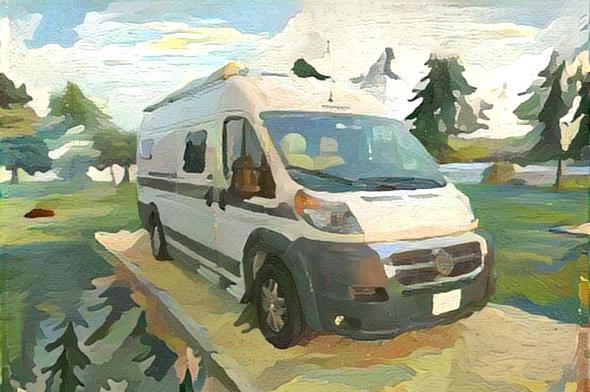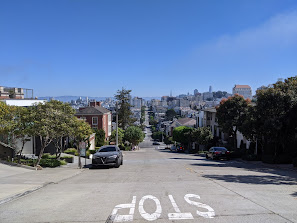We had heard that the view of El Capitan is amazing, but ... Wow! We weren't prepared for the breath-taking beauty as it rose up majestically from the Yosemite Valley. The thin layer of wildfire smoke tried, but it could not hide its grandeur.

As we left the Oregon coast and headed into Northern California, we realized that Yosemite National Park could easily be one of our next destinations if we did some ''prep work'' ahead of time. Earlier this season, the park service started limiting the number of visitors it admits into Yosemite each day in order to decrease issues with overcrowding. Visitors have to purchase a day-use reservation online for admittance on a specific day. The reservations cost $2 in addition to the regular national park admission cost of $35. Once you obtain and activate this highly sought after reservation, it is good for the following seven days. In recent years, Yosemite has struggled with traffic issues related to the nearly four million annual visitors. With the new system only 1700 reservations are available each day. What a gift we were given ... the chance to visit this hugely popular national park during a very rare ''quiet'' period.

Less traffic meant primo parking spots for Baby Beest and spectacular front-row views for us!
Since we have adopted a sort of ''plan as we go'' traveling style, we sometimes find it challenging to be in a certain place on a specific day. But for the chance to see Yosemite when the number of visitors is limited ... we will make it work! We actually secured two entrance reservations a week apart, so if we couldn't make the first reservation day on October 5, then we would still have a chance to come in a week later on October 12. Time to study up on Yosemite!
So much to see and do ... how does one decide? I could leave it totally in Doug's hands, but I am quite certain that I won't go along with his suggestion to climb Half Dome!
On our way towards Yosemite from northern California, the route skirted us around San Francisco before heading east towards Yosemite. If we added just a few extra miles to our route, we could drive across and see the Golden Gate Bridge. It was a sunny Sunday morning as we headed that direction ... seemed to be a great opportunity to photograph the landmark bridge. Unfortunately, this was our view as we approached the bridge ...
Yes, the famous San Francisco fog greeted us instead.
While we didn't get our ''photo opportunity'' this time around, we did get to partake in the second most famous San Francisco experience. Google Maps thought it was doing us a favor by helping us avoid some traffic backups on Highway 101. That ''favor'' however, involved redirecting us up a couple of those famous San Francisco side streets that have about a 25% uphill grade. Yikes! Glad my driver and Baby Beest both seemed to enjoy the challenge!
That served as a practice run for the climb later that afternoon into the mountains leading up to Yosemite. Once more driver and van accepted the challenge of taking on uphill climbs and hairpin turns that brought us high into the Sierra Nevada Mountain Range where Yosemite National Park is located. After staying overnight in a private RV park, we drove an hour through national forest land to reach the Big Oak Flat Entrance on the morning of our first entrance reservation day.
As we drove into the park, there was still a hint of smoke from wildfires that had been burning in the area off and on for the last month. Sections like this one in the national forest that surrounds Yosemite were common ... a stark reminder that we have to all do our part to prevent forest fires.
We secured our first seven-day pass and were ready to start exploring. The only problem ... it is a long drive up the mountains that lead into Yosemite. Not a drive that we wanted to repeat every morning and evening for the next few days. Happily, Doug found a last minute opening at Upper Pines Campground in Yosemite Valley for our first night there so we were able to enjoy two full days in that area of the park. Some highlights include:
Glacier Point Vista: It's a long, winding drive up with a huge payoff of spectacular views of Half Dome and other massive granite cliffs. Through our binoculars, we could see ''more adventurous than us'' rock climbers basking in their glory as they reached the summit of Half Dome.
Hike Up to Sentinel Dome: A 1.3 mile hike up to the top of Sentinel Dome provided more fabulous views of Yosemite Valley far below
Inspiration Point: It was getting late in the afternoon, so we just climbed about halfway up ... far enough to be inspired by the view!
Views Looking Up From Yosemite Valley: While riding through the many miles of Yosemite beauty, I found out that the co-pilot has a new job. I accepted the challenge of capturing scenic shots along the way and sometime ''jazz'' them up with special affects!
Camping in Yosemite Valley at Upper Pines Campground: With most of the Yosemite campgrounds closed, we were grateful to be able to secure a last minute reservation. We were surrounded by lots of other campers, but Baby Beest has all we need to keep our social distance including a small, but fully functioning interior wet bath ... thanks to Doug's fix-it skills. I am warming up to the idea that my bathroom also gets cleaned every time we take a shower.
Bridalveil Falls: Trail construction prevented us from getting any closer to this Yosemite icon and the smog that day obscured our view, but the falls were still flowing delicately ... like a bridal veil!
Merced Grove of the Giant Sequoias: This is one of three Sequoia groves in Yosemite. A 1.3 mile hike through the peaceful (and not so smoggy) forest lead us to a few Giant Sequoias that grow in the park. They are not as tall as the Coast Redwoods, but have a much wider truck circumference which makes them larger by volume than their ''cousins''.
Doug had scheduled some work to be done on our van at a Hymer specialist about three hours west of Yosemite, so we headed there with the thought that we may return to Yosemite for a day or two afterwards. But the air quality in that area was getting worse rather than better, so we used our ''flexibility'' to follow the clearer skies and ...
... snag another state capitol building in Sacrament, California
... catch a glimpse of South Lake Tahoe
... enjoy the weekend in the beautiful Carson Valley in Nevada
... capture another state capitol building in Carson City, Nevada
... check out some old western towns (and get a glimpse of autumn)
... visit an authentic ''ghost town'' at Bodie State Historical Site
... see and learn about the tufa columns (columns of calcium carbonate which form in carbonate-rich saltwater lakes) at Mono Lake which is located near the eastern entrance of Yosemite.
And thus we were able to get a ''double dose'' of Yosemite by arriving at the Tioga Pass Entrance on the day that our second park reservation started. With the air quality improving and two more nights of camping at Upper Pines secured, we were happy to continue our Yosemite experience.
Highlights of our second visit to Yosemite included:
Gaylor Lake Hike: A slight uphill climb brought us to an alpine lake overlook. But why stop there? The lakeside views were just as spectacular.
Olmsted Point: This primo vista was named in honor of the father and son landscape designers and conservationists who helped preserve Yosemite's natural beauty by encouraging that it be set aside as public land in 1864 and fully protected as our third national park in 1890. After we enjoyed another ''lunch with a view'', we climbed up a boulder field for a new prospective of Half Dome and the Yosemite Valley.
Tuolumne Grove: We walked through the second of three Sequoia groves in Yosemite. In the early 20th century, this site was popular with tourists who drove down this steep gravel road for the chance to drive their car through this burnt down but still upright Sequoia trunk.
Tunnel View Vista: Since the air quality had improved considerably since our visit last week, we decided to return to our favorite Yosemite viewpoint. We were doubly delighted when we realized that the setting sun was at just the right angle to turn Bridalveil Falls into a colorful rainbow which Doug captured by connecting his phone camera lens to the binocular lens.
Mirror Lake Trail: Mirror Lake ... sounds like it could be a spectacular sight in the midst of all the towering granite peaks, right? We biked to the trailhead near our campground and hiked a short distance to where the lake should have been. No amazing Mirror Lake here, as the man-made dam that created the lake years ago was taken down ... leaving a more natural, but dried up river bank.
Biking Around Yosemite Valley: There were a number of miles of bike/pedestrian paths that led us past some amazing scenery. Even with tourist numbers down, as evidenced by the many tour buses sitting idle, the bike paths were still very crowded and not well signed. We are not sure if we would feel comfortable biking around this central hub of activity during more normal, busy times.
And we saved the best for last ...
Hike Up to Artist Point: From the Tunnel View parking area, we climbed up towards Inspiration Point but took a side path that actually used to be the road going into Yosemite. The path was quiet and the view made me wish that I had a bit of artistic talent so that I could paint this lovely scene.
But it will be etched in our hearts as we forever savor the double dose of Wow that we were able to enjoy at Yosemite National Park!























































































